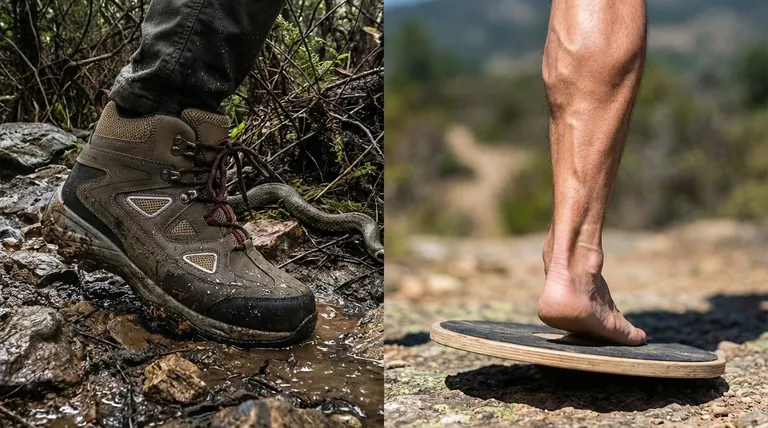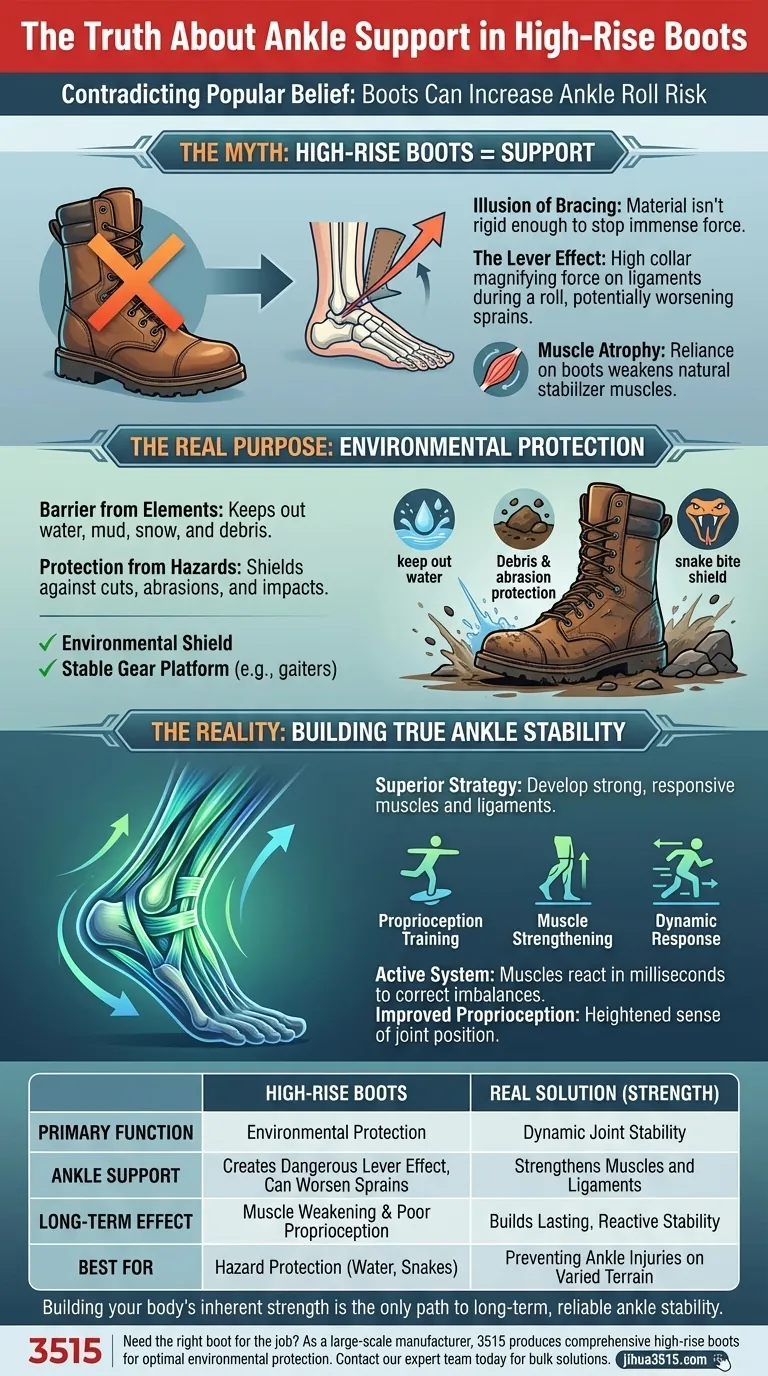Contrary to popular belief... high-rise boots don't actually offer effective ankle support. The reference material is clear: they can even increase the risk of ankle rolls. Building strength in your ankle muscles is the superior strategy for true stability.
The perceived stability from a high-rise boot is largely an illusion. True ankle support comes from developing strong, responsive muscles and ligaments, not from immobilizing the joint with external bracing.
I'd need to explain why this is the case. Firstly, the material of a boot, even a high-rise one, simply isn't rigid enough to withstand the forces involved in a stumble. It gives a feeling of support, but it's more like proprioceptive feedback, not true mechanical support.
In fact, a high boot can act as a lever. During a roll, the boot's collar increases the force on the ankle joint, potentially leading to a more severe sprain. This is a common, and often overlooked, biomechanical reality.
Furthermore, relying on a boot can lead to muscle atrophy and decreased proprioception. The stabilizing muscles around the ankle don't get the stimulus they need to stay strong, and your brain relies on the boot's pressure instead of your own sensors.
So, what are high-rise boots good for? Mainly for protection from the elements – keeping out water, mud, and debris. They also shield against abrasions, cuts, and hazards like snake bites. Another benefit is they offer a stable platform for attaching gear, like gaiters.
The truly effective solution? Building functional ankle strength. Muscles are dynamic and can react in milliseconds to correct imbalances, something a passive boot can't do. Stronger ankles have better proprioception - a heightened sense of joint position in space. Single-leg balances, calf raises, and wobble boards are some examples.
So, what footwear should you choose? It depends on your needs.
- If preventing ankle rolls is your priority on varied terrain, low or mid-cut shoes, which promote ankle mobility and proprioception, are best, coupled with an ankle-strengthening program.
- If environmental protection is key (water, snakes), a high-rise boot is ideal for its barrier qualities, but remember to rely on your strength for stability.
- If you have a pre-existing medical condition or a recent injury, consult a medical professional for their recommendations.
Building your body's inherent strength is the only path to long-term, reliable ankle stability. Contrary to conventional wisdom, high-rise boots do not provide effective ankle support. The provided information is clear that not only are they ineffective, but they can actually increase the risk of an ankle roll. The superior solution for genuine stability is to strengthen the muscles and ligaments surrounding the ankle joint.
The perceived stability from a high-rise boot is largely an illusion. True ankle protection comes not from immobilizing the joint with external material, but from developing strong, responsive muscles that can prevent a roll before it happens.

The Counterintuitive Mechanics of Ankle Support
Many of us were taught that a taller boot braces the ankle, but a closer look at biomechanics reveals why this is a flawed assumption. The forces involved in a stumble are far greater than the structural integrity of a typical boot.
The Illusion of Bracing
The feeling of security a tall boot provides is mostly proprioceptive—the material pressing against your skin gives your brain more feedback on your ankle's position. However, the leather or fabric of a boot collar is not rigid enough to stop the immense force generated when your body weight goes over on your ankle. It cannot function as a true medical brace.
The Dangerous "Lever" Effect
The primary issue is that a high boot collar can act as a lever. When your foot begins to roll, the force is applied to the ankle joint. A high collar creates a higher pivot point, which can increase the leverage and magnify the force on your ligaments, potentially turning a minor twist into a more severe sprain.
Weakening Your Natural Defenses
Constant reliance on an external "support" system can have a deconditioning effect. The small, crucial stabilizer muscles in your ankles get less work, causing them to weaken over time. This makes you more susceptible to injury when you are not wearing the boots.
The True Purpose of High-Rise Boots
If not for ankle support, then why do high-rise boots exist? Their purpose is critically important, but it is about protection from external threats, not internal joint stability.
Barrier from the Elements
The most common function of a tall boot is to act as a barrier. It excels at keeping water, snow, mud, and debris from getting inside your footwear, which is essential for comfort and health in harsh conditions.
Protection from Hazards
A sturdy high-rise boot provides excellent protection from environmental hazards. This includes abrasions from rocks, impacts, cuts from sharp objects, and even snakebites.
Building Real Ankle Stability
The most effective way to prevent ankle injuries is to build a robust, dynamic support system within your own body. This is achieved through targeted strengthening and conditioning.
Why Muscle is Superior
Unlike a passive boot, muscles are an active and responsive system. They can contract in milliseconds to correct an imbalance, absorbing shock and keeping the joint within its safe range of motion.
Training for Proprioception
Proprioception is your body's innate sense of its position in space. Exercises like single-leg balances force the nerves and muscles in your ankle to communicate more effectively, improving your reaction time to uneven ground and preventing missteps.
Making the Right Choice for Your Goal
Your footwear choice should be dictated by the actual hazards you face, not a false sense of ankle support.
- If your primary focus is preventing ankle rolls on varied terrain: Choose low or mid-cut shoes that allow for natural ankle mobility and pair them with a dedicated ankle strengthening program.
- If your primary focus is protection from environmental hazards like water, deep mud, or snakes: A high-rise boot is the correct tool for the job, but understand you must still rely on your own strength for stability.
- If you have a pre-existing medical condition or acute injury: Disregard this general advice and consult a medical professional for specific recommendations, which may include a prescribed orthopedic brace.
Ultimately, investing in your body's inherent strength is the only reliable path to long-term ankle stability.
Summary Table:
| Aspect | High-Rise Boots | Real Solution |
|---|---|---|
| Primary Function | Environmental protection (water, debris) | Dynamic joint stability |
| Ankle Support | Creates a dangerous lever effect, can worsen sprains | Strengthens muscles and ligaments |
| Long-Term Effect | Can lead to muscle weakening and poor proprioception | Builds lasting, reactive stability |
| Best For | Hazard protection (snakes, abrasions) | Preventing ankle injuries on varied terrain |
Need the right boot for the job? As a large-scale manufacturer, 3515 produces a comprehensive range of high-rise boots designed for optimal environmental protection and durability. Whether you are a distributor, brand owner, or bulk client needing footwear for hazardous conditions, our production capabilities ensure quality and reliability. Let's discuss your specific needs and find the perfect protective solution for your customers. Contact our expert team today to get started.
Visual Guide

Related Products
- Safety Footwear Wholesale Manufacturer for Custom OEM/ODM Production
- Wholesale Safety Footwear Manufacturer for Bulk & Custom OEM Orders
- Premium Flame-Retardant Waterproof Safety Boots and Shoes
- Premium Wholesale Tactical Style Safety Shoes Boots with Quick Lacing
- Factory-Direct Wholesale Canvas Boots with High-Traction Rubber Soles
People Also Ask
- What are the differences between steel toe, composite toe, and alloy toe Wellington boots? Choose the Right Safety Toe for Your Job
- Do snake bite boots work? Your Ultimate Guide to Effective Snake Bite Protection
- Is it normal to wear shoes in the house? A Guide to Hygiene, Comfort & Culture
- How do safety shoes contribute to cost savings for companies? A Strategic Investment in Risk and Cost Management
- What cultural and environmental considerations are tied to wearing shoes indoors? Balance Hygiene, Tradition, and Foot Health



















